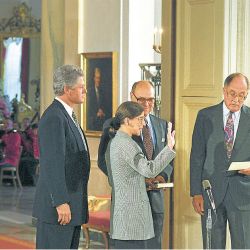Ruth Bader Ginsburg, RBG, perhaps the most progressive of the nine justices that sit on the US Supreme Court, is a living legend. An iconic figure. Not only in the United States – where she has made history in the high court after being nominated for a seat by president Bill Clinton – but in the wider world too, where her advocacies and rulings on both human and women’s rights have been closely watched since the 1960s. Equality is key to her worldview. “Defending the equal-citizenship stature of women and men as a fundamental constitutional principle” is her motto.
In recent years, her reputation has crossed over into popular culture. Her dissents in court – especially one she read in June, 2013 on a voting rights case (Shelby County v. Holder) – have won plaudits and popularity, helping to turn the living legend hip. RBG groupies began to sprout up as she became a cult figure. An RBG character was created for the Saturday Night Live TV show. Cartoon Network had an action figure named “Wrath Hover Ginsbot.” T-Shirts with “Notorious RBG” printed on them sold out. The powerful grandmother justice, today aged 84, has fans. Resign because of age? Why leave this court that has lurched to the right?
Justice Ginsburg is petite and her voice is soft. Her hair is combed back severely. Her eyes are vividly bright. Though she has been living in DC for the last 35 years, her accent still speaks of Brooklyn. At times, she goes quiet, as as if she has switched off. But don’t be fooled: she is weighing her words carefully, in order to come back with a swing, elegant as she is, with the right answer.
She lights up when she speaks of her beloved late husband, Marty. She doubles in size when she recalls her dissents. They come back to her like the moment is being played live again. She says that she will remain on the bench as long as she can do the job full steam. Her memory is astonishingly accurate. She can remember every detail, every date, every name from the cases she cares for. She bluntly says “I cannot comment” but immediately, almost overlapping with herself, starts responding nonetheless.
RBG seldom sits for interviews. Last week she received the Buenos Aires Times at her chambers in the Supreme Court in Washington.
- You will return to Argentina in early May, for the Biennial Conference of the International Association of Women Judges, which will be chaired by an Argentine Justice, Susana Medina.
- I met my good friend Justice Susana Medina on my first visit to Buenos Aires (2009). I had been invited to attend a colloquium with other justices from the Americas. It was then when I met late justice Carmen Argibay… I was so taken by her and by her story. I also visited the Colón Opera House, while the renovation was in progress, so I am very eager to go back now that it is done.
- You have hired law clerks [for your office] until 2020, so it looks as you intend to stay until the next presidential election. Would you have stepped down if Hillary Clinton had been elected?
- I cannot answer that. I can give, instead, this very good answer: Justice [Louis] Brandeis was appointed to this court when he was 60, the same age I was, and stayed for 23 years. I hoped to stay at least that long, but now I am two years beyond that. I also said that I would not leave before this painting here [by German artist Josef Albers], on loan from the Museum of American Art, was back in my chambers after a travelling tour of five years. It is back, so I now say: “I will remain as long as I can do the job full steam.”
- In 1993 you were confirmed by 96 votes to 3. In 2017, Justice Neil Gorsuch was confirmed 54 to 45, indicating a polarised vote in the Senate. Can the old times, of majority confirmation, come back?
- Times have changed radically. The vote on my appointment was 96 to 3 even though I had spent 10 years of my life as a feminist litigator in the ACLU [American Civil Liberties Union]. There was a true bipartisan spirit prevailing in our Congress in those years. In the last four appointments it hasn’t been that way. My dream is that we get back to the way it was and should be: that is, that judges are not politicians and they should be approved on the basis of their qualifications as judges and not on whatever their party registration might be.
- You recently said that the true symbol of the US is not the bald eagle but the pendulum, which in case it swings too far…
- I think it is time for it to swing back. It hasn’t yet but I think inevitably it will.
- Every morning, the US and the world awake to a barrage of angry tweets from President Trump. Is it correct to remain silent? Is it something for the Judiciary to comment on?
- The press is tremendously important in informing the public what is going on. And not only today. It has been shown, in the [recent] movie [The Post] about the Pentagon papers and the [Washington] Post; that story might have never come out if the press would not have been as free as it is.
- But the press is being lambasted, labelled as “fake news,” as “failing” newspapers by Trump. Are we, the people from the media, going to prevail here?
- Well well, right now “we, the people” is disgusted with everyone (Laughs). And the press, you know, is not monolithic. I read the New York Times and the Washington Post and they have been trying to report and tell the public what is going on. Of course there are other media outlets.
- Will there ever be an all-female US Supreme Court?
- It is certainly conceivable. It is one of the areas that make me really hopeful. When I went to law school in ancient days, in the end of the 1950s, women were three percent of [all] the lawyers in the US. There were nine women in my entering class and over 500 men. Today in that law school it’s 50/50. Nowadays, even this Court, without a majority, we are three and one third of the bench.
- Was there a turning point in that fight?
- The president who really did it, who made the change, was Jimmy Carter. When I graduated from law school, there had been only one woman ever to be on a federal appellate court, Florence Allen, a friend of Eleanor Roosevelt, appointed in the 1930s to the Sixth Circuit of the US Court of Appeals. President Carter was not a lawyer but he was determined to change the complexion of the US Judiciary. He believed it should be flattened, to all of the people and not only to white men; so he appointed 11 women to various courts of appeals – I was one of those lucky ones – and over 25 women to the trial courts; the same with minority groups.
No president has ever gone back to the way it was; it was critical mass as opposed to women being one-at-a-time curiosities. It was a tremendous change. Not only did he give women who were already in the law profession an opportunity to aspire to judicial posts but he encouraged young ones who might like the law to go for it.
- One year on from the Women’s March held in Washington after President Trump’s inauguration, has there been any change?
- We will see, in 2018, more women running for public office than ever before. And I think that has been hugely stimulated by the Women´s March, realising that if you are going to change you have to be in a decision-making position. Not just in Congress but in positions in the states’ legislatures.
- What is your take of the ‘me too’ movement?
- I just hope that the ‘me too’ extends [down] to the lowest level. Hollywood is all right; everybody listens when famous actors tell a story. But what about the maid working at a hotel?
There are signs that this thing is sinking through. My first reaction is that this is understood to be a power relationship and a man-subordinated ordeal that used to be, in my growing-up times, [like] when a man was overbearing… people would say “Weeeeell, boys will be boys, this is the way it is…” Some of the experiences that the ‘me too’ people are telling of, everyone in my generation had a similar experience but did not dare to complain about it.
- Is the US still a moral beacon, one that shows the right and wrong to the world?
- I cannot comment on that. I can say that my own awakening to gender discrimination – I knew it was there but just had to accept it and try to get over it – was when I was in Sweden in 1962 and 1963. They, the Swedes, were far ahead of the other Scandinavian countries and quite ahead from the US in the appreciation that the society needs to draw an intelligent morale from its people. At least, half of the [world’s] brain power is possessed by women, so we should not underuse it.
- In a polarised world, with huge political divides almost everywhere, how does a dissent find place in a court that is meant to rule by consensus?
- If I am dissenting over what a statute passed by Congress means, I can say that if this court has made what I regard as a dreadful mistake, Congress can fix it.
That happened, to my great satisfaction, in the Lilly Ledbetter case [Ledbetter v. Goodyear, 2007, in which employers cannot be sued under Title VII of the Civil Rights Act over race or gender pay discrimination if claims are based on decisions made by the employer 180 days ago or more] which this court had a divided decision over by four to five. And a couple of years later Congress passed the Lilly Ledbetter Fair Pay Act (2009). The president [Barack Obama] sent me a replica of the signing of that bill.
So dissent is meant to bring the attention of Congress and the public also. An incident from the 1970s, when this court decided that discrimination on the basis of pregnancy is not discrimination on the basis of sex. So as there were two kinds of people, non-pregnant people –and that means women and men – and then pregnant people. Those are only women: so that it can’t be gender-based discrimination. It was such wrong thinking! Discrimination on the basis of pregnancy is discrimination on the basis of sex.
- And what about dissenting in constitutional ruling?
- Then the Legislative cannot change it and the only hope is that a later court will see the wrong pattern that the court has taken. And we have seen that time and again; even with the worst decision that this court has ever made, the Dred Scott decision [from 1857, where no black, free or slave, could claim US citizenship], dissenting opinions becoming the law of the land at later time.
I think the most famous example of that are the free speech dissents of justices Holmes and Brandeis. Those dissents are now unquestionably protecting the right to think, speak and write as one believes and not as the government tells you is the right way. Those dissents are now law.
When I dissent, I am always heartened to remember that history has dissents becoming the law of the land. And that is when a later court sees the errors that its predecessors made.
RGB AND SEX EDUCATION. A story about Ruth Bader Ginsburg, a personal favourite, concerns her attempts to tackle sexual inequality. She once explained why she decided to use the term “gender discrimination” instead of “sex discrimination” in her legal work. Her secretary at Columbia in the 1970s, who typed her briefs, articles and speeches, once reportedly said: “I have been typing this word sex, sex, sex, over and over. Let me tell you, the audience you are addressing, the men you are addressing … the first association of that word is not what you are talking about. So I suggest that you use a grammar-book term. Use the word gender. It will ward off distracting associations.” RGB saw the logic in the approach and adopted the tactic, to great effect. (Taken from a transcription by then-senator Joseph Biden, after Justice Ginsburg’s hearings at Congress in 1993)
BIO. Justice Ginsburg received her B.A. from Cornell University, attended Harvard Law School, and received her LL.B. from Columbia Law School. In 1971, she was instrumental in launching the Women’s Rights Project of the American Civil Liberties Union. She served as the ACLU’s general counsel from 1973–1980, and sat on its national board of directors from 1974–1980. She was appointed judge to the United States Court of Appeals for the District of Columbia Circuit in 1980. President Bill Clinton nominated her as an associate justice of the Supreme Court in June, 1993, and she took her seat August 10, 1993.





























Comments